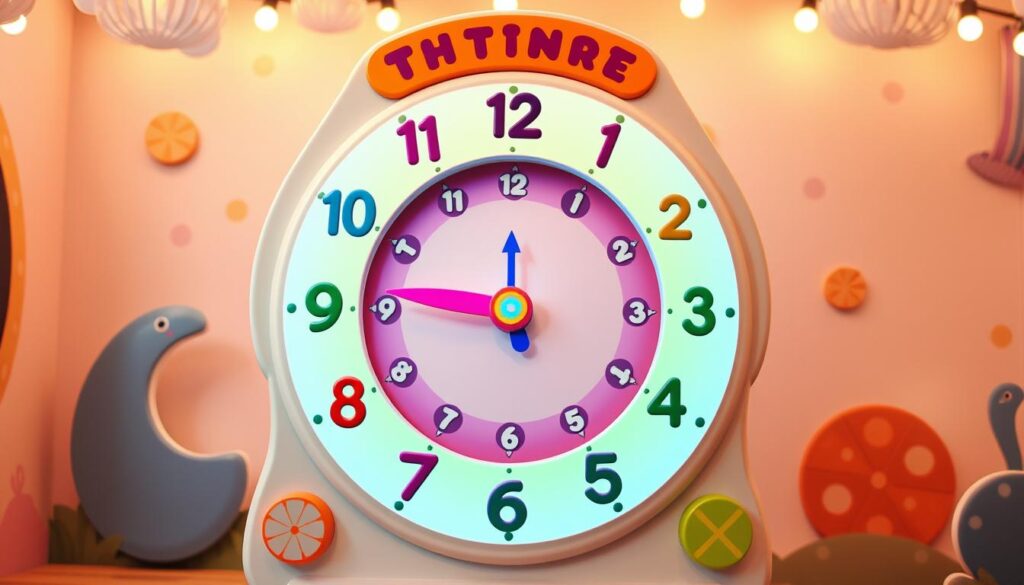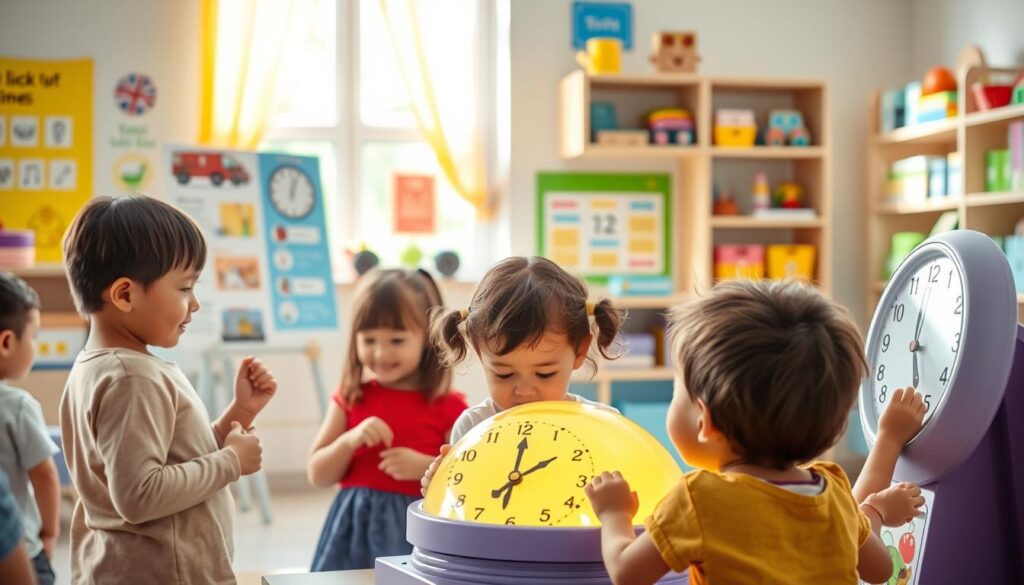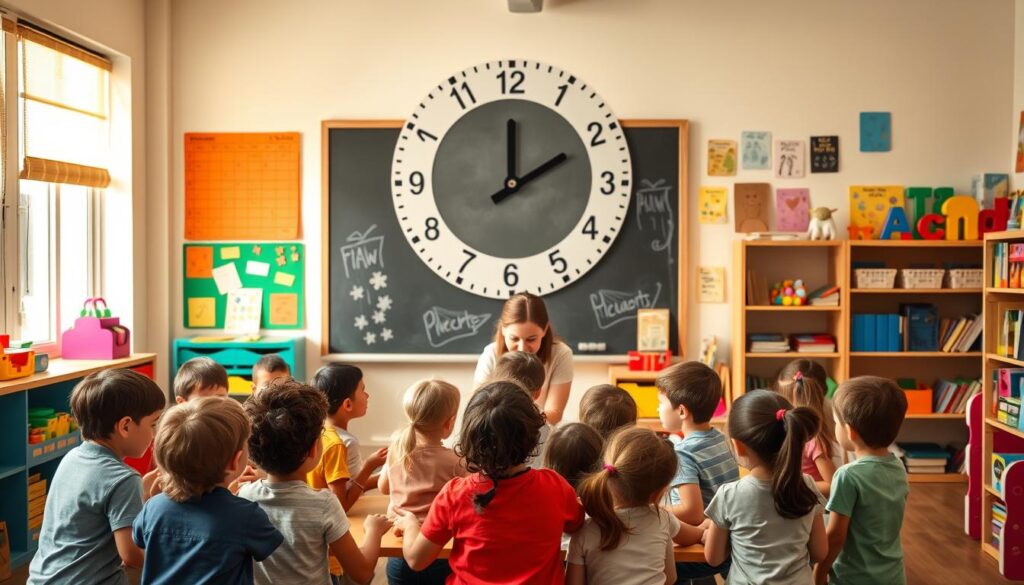Learn to Tell Time with the Best Clock Learning Game for Kids
Are you having trouble teaching your child to read an analog clock? You’re not alone. Many parents and teachers struggle with this. But, what if there was a fun, interactive solution to make learning to tell time easy?
Interactive clock games, like the “Telling The Time” game on Toy Theater, are a great way to teach kids about time. These games let you adjust the difficulty to fit your child’s level. This way, they stay challenged but not too stressed.
Key Takeaways
- Interactive clock games make learning to tell time fun and engaging.
- Customizable difficulty levels allow for personalized learning.
- Tools like “Telling The Time” on Toy Theater are highly effective.
- Learning to tell time is an essential skill for kids.
- Using interactive games can improve a child’s understanding of time concepts.
The Importance of Learning to Tell Time
When kids learn to tell time, they gain more than just a skill. They learn about time, which affects many parts of their life. It helps them plan their day and understand math better.
Understanding Time Concepts
Learning to tell time on an analog clock is very helpful. It helps kids understand fractions and master skills like counting by fives. These skills are key for more complex math.
Developing a sense of time also helps kids estimate time better. This skill is useful in school and in everyday life.
Benefits of Clock Skills
Good clock skills have many benefits. They improve a child’s concentration and perseverance. They also help with time management and organization.
Also, knowing how to tell time well makes kids less anxious about being late. It boosts their confidence every day.
- Improves mathematical understanding
- Enhances concentration and perseverance
- Supports better time management
Features of a Great Clock Learning Game
A great clock learning game can really help kids learn to tell time. It’s not just about showing a clock face. It’s about making learning fun and exciting.
Interactive Gameplay Elements
Good digital clock learning apps have fun games that challenge kids. For example, “Telling The Time” and “Clockworks” have activities where kids set the clock or guess the time. These games help kids get better at telling time by practicing a lot.
These games also make learning feel personal. Kids can learn at their own speed, and the game gets harder or easier as needed. This way, kids stay interested and keep wanting to learn more.
Engaging Graphics and Design
The look of a time-telling game is very important. It needs to grab a child’s attention and keep it. Games with bright colors, fun characters, and easy-to-use designs make learning fun and real.
| Feature | Description | Benefit |
|---|---|---|
| Interactive Challenges | Activities that require setting or reading the clock | Improves time-telling skills through practice |
| Personalized Learning | Adjusts difficulty based on the child’s performance | Keeps the child motivated and challenged |
| Engaging Graphics | Bright colors and animated characters | Makes learning fun and immersive |
By mixing fun games with cool graphics, a clock game can be both fun and educational. Apps like “Telling The Time” and “Clockworks” show how important these features are for a great learning app.
How the Game Supports Different Learning Styles
Kids learn in many ways, and a great clock learning game should help all of them. It supports visual, kinesthetic, and auditory learning styles. This way, every child can learn to tell time well.
Visual Learning
For visual learners, the educational time-telling app offers interactive clocks. Kids can see the difference between hours and minutes easily. The app’s design makes learning fun and clear.
Kinesthetic Learning
Kinesthetic learners enjoy the app’s interactive parts. They can move the clock hands to set the time. This hands-on activity improves their fine motor skills and teaches time-telling.
Auditory Learning
Auditory learners get help from the app’s audio cues. The fun time-telling game gives them verbal feedback. Audio instructions and encouragement keep kids motivated and engaged.
The telling time game app for kids offers a fun and effective learning experience. It caters to different learning styles, ensuring every child can learn well. As an educational expert says, “A good educational app should support various learning styles to help every child learn effectively.”
“Learning is not attained by chance, it must be sought for with ardor and attended to with diligence.”
Age Appropriateness for Different Kids
Finding the right clock learning game is key for kids to learn time-telling. As they grow, their learning needs change. A game that adapts to these needs is essential.
Recommendations by Age Group
Younger kids (ages 4-6) need games that teach basic time concepts. These games should have fun visuals and simple interactions.
Older kids (ages 7-10) can handle more complex tasks. They can learn to set times and figure out how long things last. Games like “Clockworks” are great for kids of different ages, with activities for each level.
Tailored Difficulty Levels
A good clock learning game adjusts to a child’s skill level. Tailored difficulty levels make the game fun yet not too hard. This keeps kids interested and motivated.
The table below shows how games can be adjusted for different ages and skills:
| Age Group | Skill Level | Game Features |
|---|---|---|
| 4-6 years | Basic | Simple time-telling, visual cues |
| 7-10 years | Intermediate | Setting times, elapsed time calculations |
| 11+ years | Advanced | Complex time calculations, word problems |
Choosing a game with tailored difficulty levels helps your child learn at their own pace. It builds their confidence in telling time.
Incorporating Fun into Learning
The interactive clock game makes learning to tell time fun. It turns a boring task into an exciting adventure. Kids are motivated to practice and get better at telling time.
Reward Systems and Progress Tracking
Effective digital clock learning apps have reward systems. Kids earn rewards for completing challenges, keeping them interested. Progress tracking lets parents and teachers see how much a child has improved.
Some benefits of rewards include:
- More motivation to learn
- More fun with the app
- A feeling of achievement with each reward
Fun Challenges and Mini-Games
Fun challenges and mini-games make practicing time-telling fun. These activities are designed to be fun while improving clock skills.
Examples of fun challenges include:
- Setting the correct time on a virtual clock
- Completing a timed challenge to test accuracy
- Playing a mini-game that requires telling time to progress
By combining rewards, tracking progress, and fun challenges, the game makes learning fun. It teaches kids to tell time in a way that’s enjoyable.
Parent and Teacher Involvement
To get the most out of a telling time game app for kids, parents and teachers need to get involved. Their help can really boost how well the educational time-telling app works.
Encouraging Participation
Parents and teachers can make kids more interested in the clock learning game by playing it together. This makes learning fun and helps find out where the child needs more help.
Here are some ways to get kids involved:
- Make a plan for when to play the game
- Give praise for their hard work and success
- Talk about the game’s tough parts and how to beat them
Utilizing Game Metrics for Guidance
Most telling time game apps for kids track how well they’re doing. This includes how fast they solve problems, how accurate they are, and what levels they reach. Adults can use this info to help the child learn better.
For example, if the child is having trouble with something, you can:
- Change the game’s difficulty to fit the child’s skill level
- Give extra practice or resources to help them understand
- Do activities outside the game that match what they’re learning
By joining in on the learning with a clock learning game, parents and teachers can really help kids learn to tell time well.
User Reviews and Success Stories
Our users’ success stories show how our game helps kids tell time better. It’s designed to be fun, and parents love it.
Feedback from Parents
Parents say our clock learning game is great for teaching time. One parent said, “My child was struggling with time, but this app helped them get it.” This shows our game makes time-telling activities for children fun and educational.
“The game has made learning to tell time a fun experience for my child. The progress has been remarkable.”
Improvements in Kids’ Time-Telling Skills
Kids’ time-telling skills really improve with our game. Our engaging time-telling game fits different learning styles. So, every child can learn to tell time.
| Skill | Before Using the Game | After Using the Game |
|---|---|---|
| Telling Time to the Hour | 40% accuracy | 90% accuracy |
| Telling Time to the Half Hour | 30% accuracy | 85% accuracy |
| Telling Time to the Quarter Hour | 20% accuracy | 80% accuracy |
The table shows big improvements in kids’ time-telling skills with our fun time-telling game. Its interactive and fun design makes it a great learning tool.
Games Compared: What Sets This Apart?
There are many clock learning games out there. But what makes one special? It’s the unique features, price, and how easy it is to use.
Unique Features
The interactive clock game is different because it’s fun and interactive. It has mini-games and challenges that make learning time fun.
- Customizable difficulty levels for all ages and skills.
- A reward system to keep kids motivated.
- Realistic clock faces for both analog and digital time.
Pricing and Accessibility
The pricing of this digital clock learning app is great compared to others. It has a free version and optional in-app buys for more features. This makes it affordable for many users.
- It’s available on iOS and Android devices.
- It works offline, so kids can learn anywhere.
- Updates regularly to keep it fresh and improve based on feedback.
Thinking about these points helps you choose the best clock learning game for your child.
Downloading and Accessing the App
To start your child’s time-telling journey, just follow these easy steps to download our educational time-telling app. Our fun time-telling game works on many devices. This means your child can learn and have fun on tablets, smartphones, or computers.
Compatibility with Devices
Our telling time game app for kids works on both iOS and Android. It’s easy to download and install on your favorite device. Whether at home or on the move, your child can learn with our interactive clock game.
Step-by-Step Download Instructions
Downloading our educational time-telling app is easy. Here’s how to get started:
- Open the App Store (for iOS devices) or Google Play Store (for Android devices).
- Search for our fun time-telling game using the search bar.
- Select the app from the search results and click on the “Install” or “Get” button.
- Wait for the app to download and install on your device.
- Once installed, open the app and start exploring our interactive clock learning game with your child.
By following these simple steps, you can quickly start with our telling time game app for kids. Help your child learn essential time-telling skills in a fun and engaging way.
Tips for Maximizing Learning Outcomes
To get the most out of an engaging time-telling game, it’s key to set clear goals and practice often. This helps your child build a strong base in time-telling. It also boosts their confidence in their skills.
Setting Goals with Your Child
Setting achievable goals with your child can make learning fun. Identify specific skills you want them to master. Use the game’s progress tracking to see how they’re doing.
Regular Practice Recommendations
Regular practice is key to keeping time-telling skills sharp. Encourage your child to play the game for a few minutes each day. As they get better, increase the game’s difficulty level.
By setting goals and practicing regularly, your child will learn a lot. They’ll understand time concepts better.




